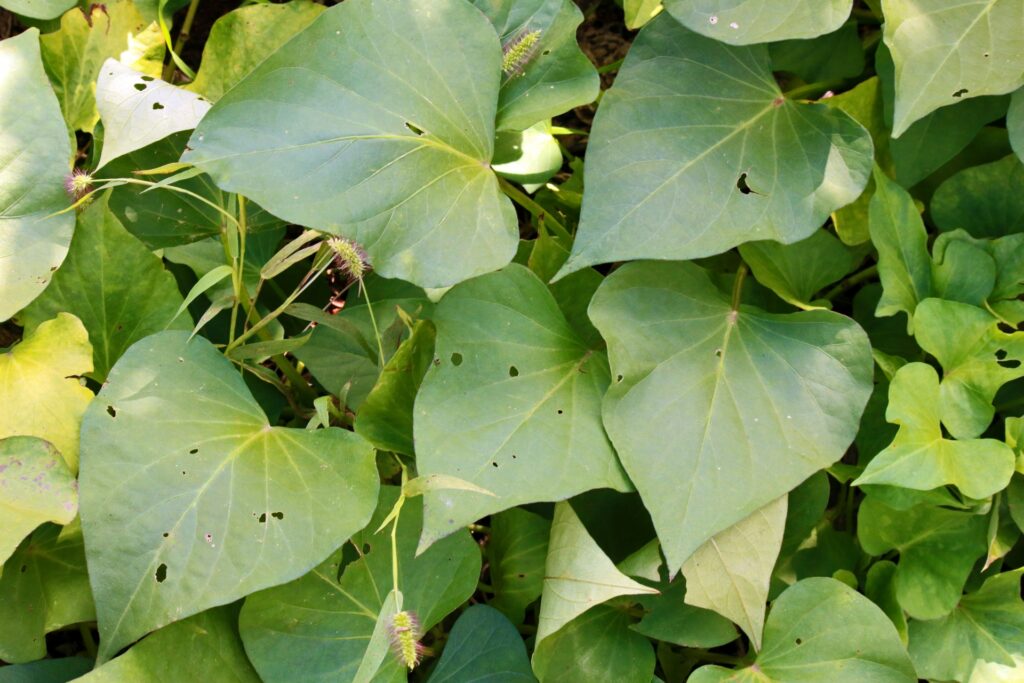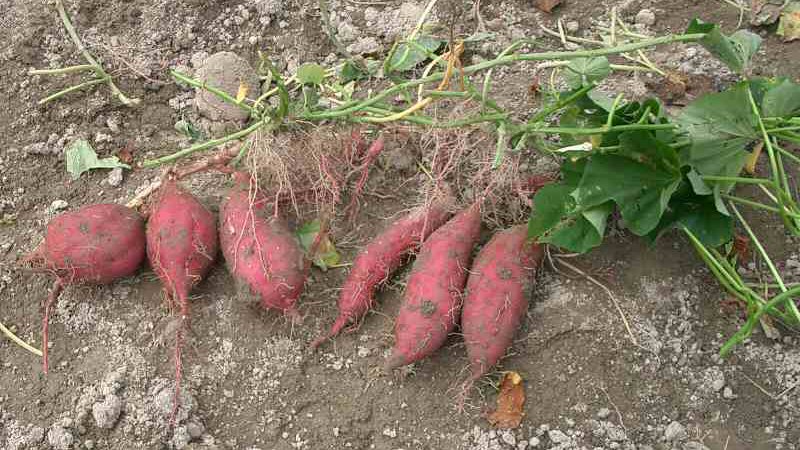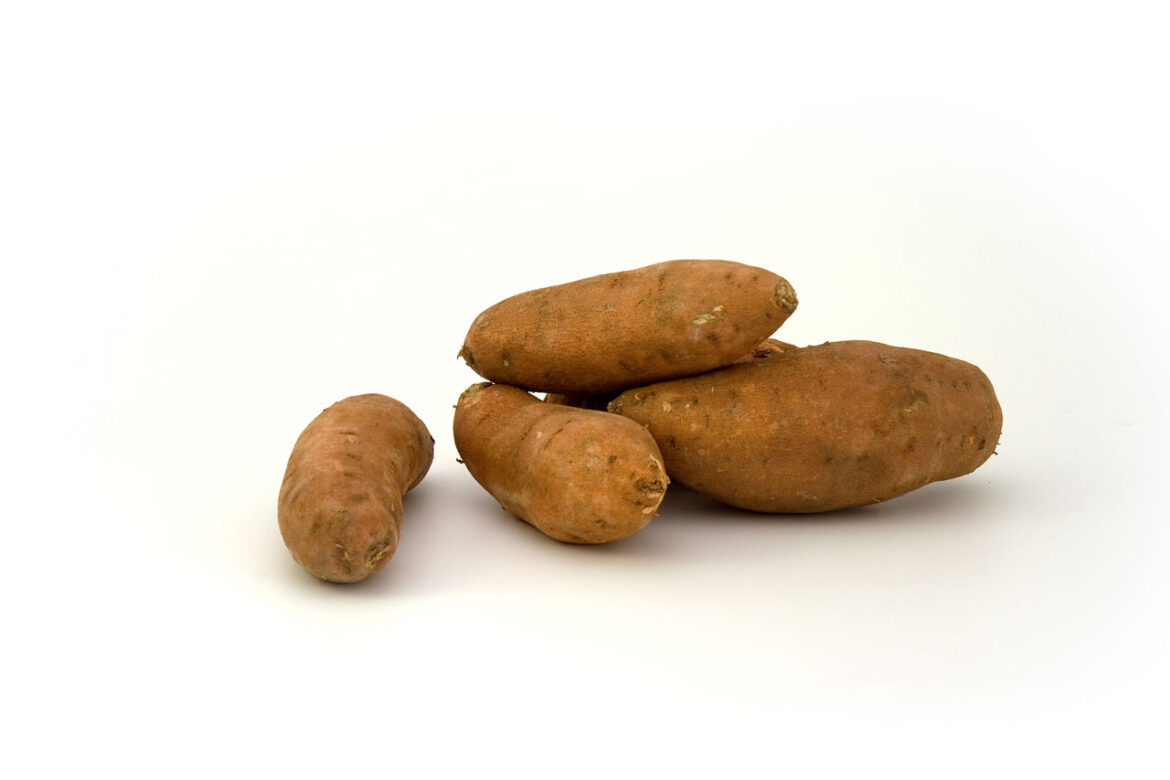Where to Grow Sweet Potatoes
Sweet potatoes can be grown wherever a minimum of four months of warm growing season can be satisfied. They can be grown in colder climates with the use of black plastic mulch to keep them warm. The sweet potato is a warm-season crop, very tender to frost and light freezes. Other than extreme sensitivity to frost, sweet potatoes are easy to grow, mostly pest free, and once the transplants are anchored, they are drought hardy. They are one of the few crops native to North America.
In cooking recipes, the words yam and sweet potato are typically equivalent. A yam is much larger, and comes from South America; they can be up to 8 feet long, and weigh up to 100 pounds. A sweet potato is typically less than 12 inches long and weighs about 1 pound. There are many who claim the sweet potato is the single most nutritious vegetable on the planet. The sweet potato grows like a vine, the tips of which are very attractive to any plant-eating wildlife in your area.
Recommended Varieties of Sweet Potatoes
Centennial; Porto Rico; Goldmar; Nemagold
Soil for Growing Sweet Potatoes
A light, sandy, not too fertile soil. This is the key, as too fertile ground will produce all top and no tubers, while too moist soil produces poor quality tubers. Rocks and other obstructions in the soil can hamper root development.
Planting Sweet Potatoes
When –
As soon as the ground can be worked, early in the season.
How –
Start slips with a sweet potato cut in half lengthwise. Lay the cut side down in a shallow pan of wet peat moss or sand. Cover tightly with plastic wrap until sprouts appear, then unwrap. The slip is ready when it has 4-5 leaves and is 4-8 inches tall, and has roots. A second method is to place a whole potato in a jar, cover the bottom inch with water, and keep warm. When leaves from above the roots, twist sprouts off and plant in a deep flat, or if warm enough, outdoors. A third method is to take 6-inch cuttings from vine tips in fall just before frost. Place cuttings in water and, when rooted, plant in 6-inch pots set in a south-facing window for the duration of winter. By late winter you can take more cuttings from these.
Started shoots or slips are supplied by a few mail-order nurseries. Set out in rows 3-5 feet apart, with 12-15 inches between plants. To prepare the ground in spring, fill furrows with 1-2 inches of compost. Mound soil over compost to form at least 10″ high ridges. This mini-raised bed optimizes both tuber size and quality because tuber growth is easily hindered by obstructions in the soil. After all danger of frost has passed, transplant slips into these ridges. Unlike potatoes, sweet potatoes are not true tubers and keep expanding as the vine grows.
| Temperature | |
| Germination | 60 - 85 F |
| For growth | 65 - 75 F |
| Soil and Water | |
| Fertilizer | Light feeder. Low N. Before planting, place 1-2" of compost in furrows. |
| Side-dressing | Once anchored apply high P fertilizer like bone mean, about 1 cup per 10 feet of row. |
| pH | 5.0 - 6.0 |
| Water | Dry to Average |
| Measurements | |
| Planting Depth | 4 - 6" |
| Root Depth | Length of potato |
| Height (Summer Squash) | 12 - 15" |
| Width | 4 - 8 square feet |
| Space between plants | |
| In Beds | 10 - 12" |
| In Rows | 12 - 16" |
| Space Between Rows | 36 - 40" |
| Average plants per person | 5 |
| Harvest | |
| Some harvest after the vines are killed by frost, but most warn that frost damages the root. Always harvest on a dry day. Start digging a few feet from the plant to avoid damage. Bruises or cuts as small as a broken hair root will shorten the shelf life by serving as an entry point for surface rot. Dry for 1-3 hours on the ground. Do not wash unless absolutely necessary; never scrub. | |
| First Seed Starting Date: | 43 - 57 days before last frost date |
| Last Seed Starting Date: | 178 - 221 Days before first frost date |
| Companions | |
| Companions | None |
| Incompatibles | None |

How Sweet Potatoes Grow
The sweet potato is a sprawling morning glory that does not usually flower. The elongated tubers, high in starch content, are formed just below the ground surface.
Cultivating Sweet Potatoes
Once planted, the vines are usually on their own, as too much fertilizer produces all tops. Weeding is important until the vines take hold and spread.

| Storage Requirements | ||
|---|---|---|
| Cure sweet potatoes before dry storage to seal off wounds and minimize decay. Place in a warm, dark, well-ventilated area at 86-90 F and high humidity for 4-10 days. Store in a cool place, making sure they don't touch. Temperatures below 55F will cause injury. Don't touch until ready to use. | ||
| Fresh | ||
| Temperature | Humidity | Storage Life |
| 55 - 60F | 85 - 90% | 4 - 7 months |
| Preserved | ||
| Method | Taste | Shelf Life |
| Canned | Good | 12+ months |
| Frozen | Excellent | 6 - 8 months |
| Dried | Good | 12+ months |
Harvesting Sweet Potatoes
When to Harvest Sweet Potatoes
Sweet potatoes can be harvested any time after they have reached a suitable size (generally 3-4 months). Their flavor and quality will improve with colder weather. Some even wait until the frost has blackened all of the vines before harvesting. Just don’t leave them in the ground much past the first frost; the vines will start to decay, which can pass down to the tubers in a matter of days.
How to harvest sweet potatoes
Carefully dig the soil up around the roots. Tubers can grow a foot away from the plant, so give ample space to prevent nicking and damaging the skin (which will encourage spoilage). Digging is much easier when the soil is dry. In addition, mud-coated sweet potatoes are less likely to sun-dry properly and rapidly as desired. Sweet potatoes should be left in the sun for several hours, and then moved to a curing room. You can cook sweet potatoes fresh from the ground, but their natural sweetness improves after curing. The simplest curing method is to place the sweet potatoes in a newspaper-lined box in a warm well-ventilated room – ideally between 85 -90 F, at about 85% humidity for 7-10 days. After curing, move the sweet potatoes to a storage space, such as a root cellar, kept between 55-60 F with an ideal humidity of around 75%.
Sweet Potato Pests
- Voles are known to eat sweet potatoes. Natural predators like cats are usually a good deterrent for small scale home gardens.
Sweet Potato Diseases
None of major importance.
